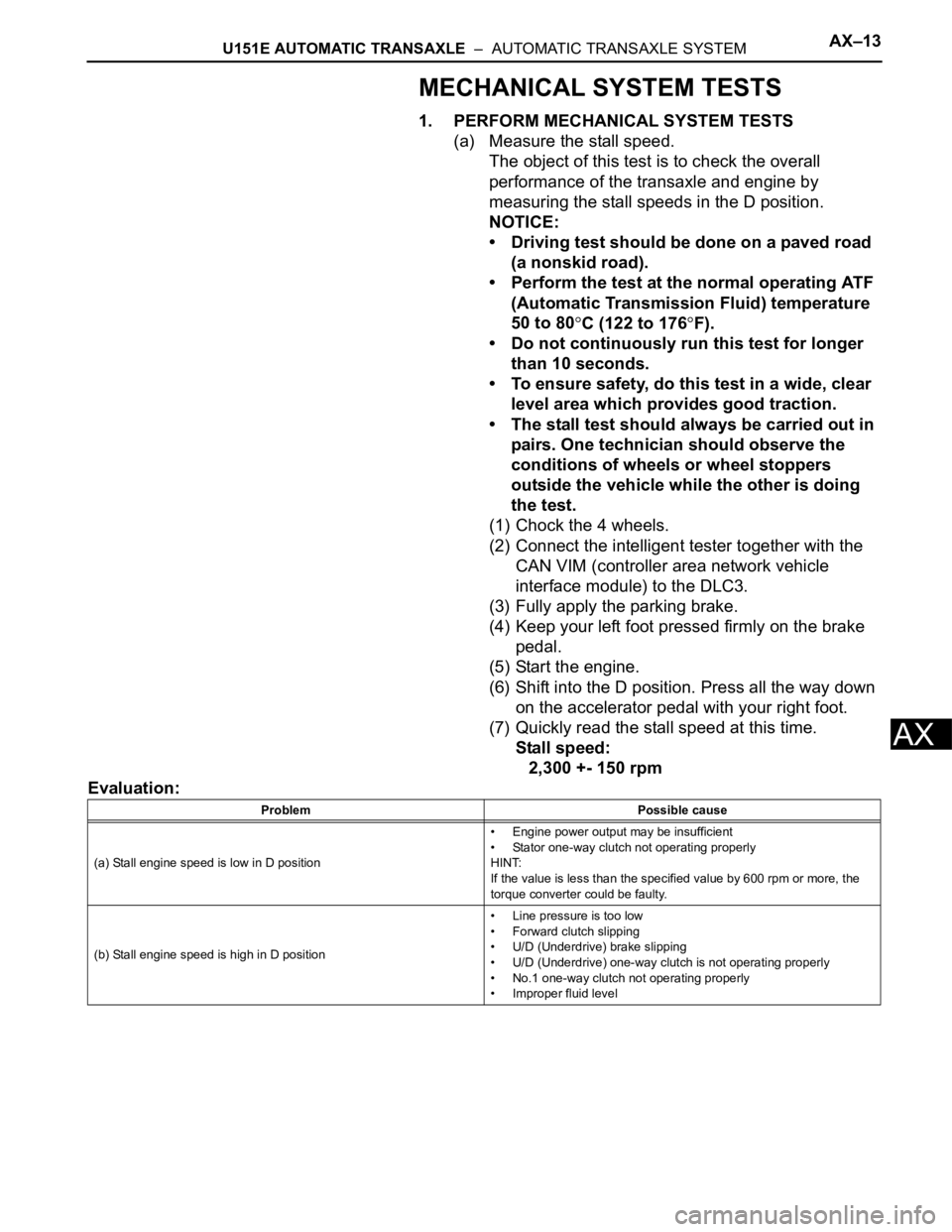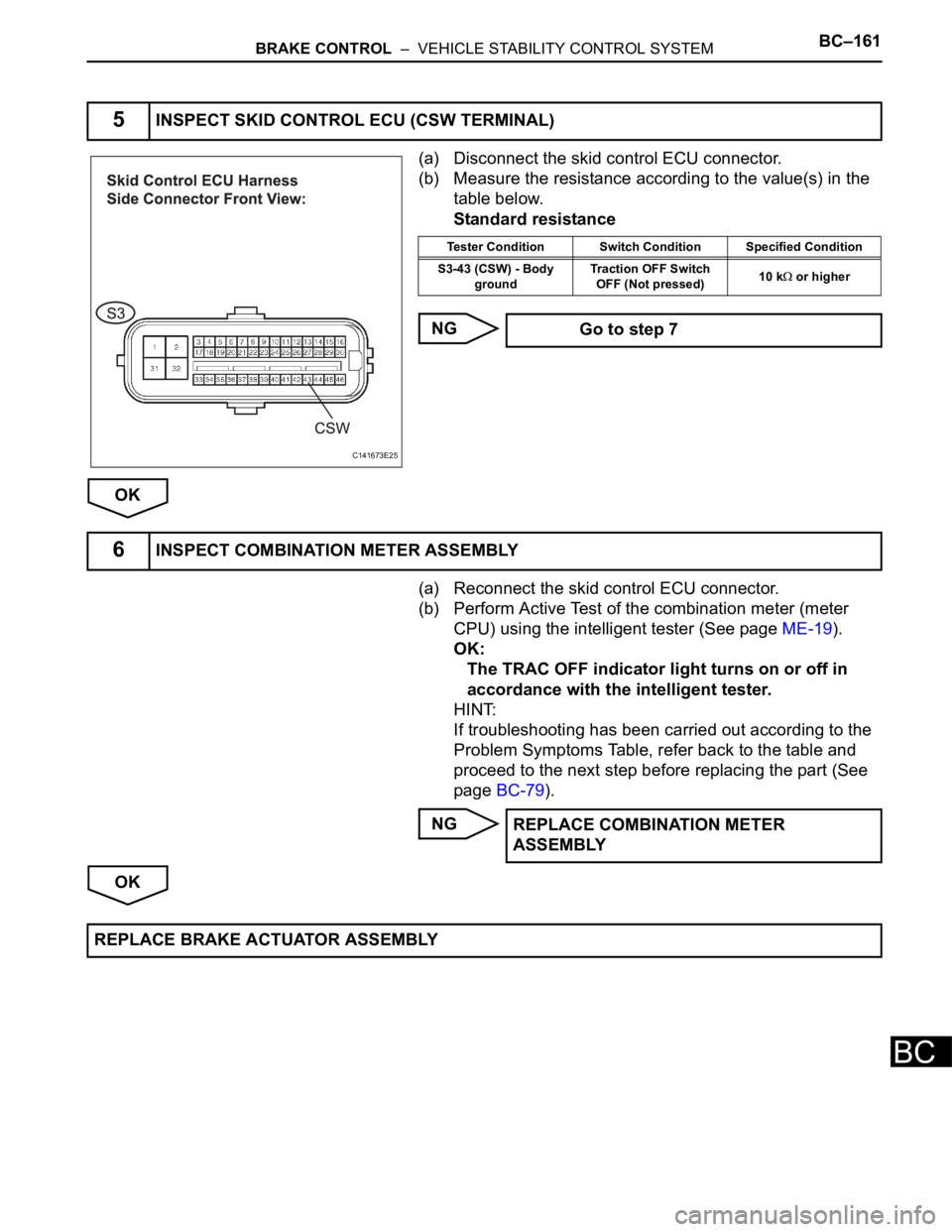2007 TOYOTA SIENNA traction control
[x] Cancel search: traction controlPage 1390 of 3000

U151E AUTOMATIC TRANSAXLE – AUTOMATIC TRANSAXLE SYSTEMAX–13
AX
MECHANICAL SYSTEM TESTS
1. PERFORM MECHANICAL SYSTEM TESTS
(a) Measure the stall speed.
The object of this test is to check the overall
performance of the transaxle and engine by
measuring the stall speeds in the D position.
NOTICE:
• Driving test should be done on a paved road
(a nonskid road).
• Perform the test at the normal operating ATF
(Automatic Transmission Fluid) temperature
50 to 80
C (122 to 176F).
• Do not continuously run this test for longer
than 10 seconds.
• To ensure safety, do this test in a wide, clear
level area which provides good traction.
• The stall test should always be carried out in
pairs. One technician should observe the
conditions of wheels or wheel stoppers
outside the vehicle while the other is doing
the test.
(1) Chock the 4 wheels.
(2) Connect the intelligent tester together with the
CAN VIM (controller area network vehicle
interface module) to the DLC3.
(3) Fully apply the parking brake.
(4) Keep your left foot pressed firmly on the brake
pedal.
(5) Start the engine.
(6) Shift into the D position. Press all the way down
on the accelerator pedal with your right foot.
(7) Quickly read the stall speed at this time.
Stall speed:
2,300 +- 150 rpm
Evaluation:
Problem Possible cause
(a) Stall engine speed is low in D position• Engine power output may be insufficient
• Stator one-way clutch not operating properly
HINT:
If the value is less than the specified value by 600 rpm or more, the
torque converter could be faulty.
(b) Stall engine speed is high in D position• Line pressure is too low
• Forward clutch slipping
• U/D (Underdrive) brake slipping
• U/D (Underdrive) one-way clutch is not operating properly
• No.1 one-way clutch not operating properly
• Improper fluid level
Page 1500 of 3000

U151E AUTOMATIC TRANSAXLE – AUTOMATIC TRANSAXLE SYSTEMAX–13
AX
MECHANICAL SYSTEM TESTS
1. PERFORM MECHANICAL SYSTEM TESTS
(a) Measure the stall speed.
The object of this test is to check the overall
performance of the transaxle and engine by
measuring the stall speeds in the D position.
NOTICE:
• Driving test should be done on a paved road
(a nonskid road).
• Perform the test at the normal operating ATF
(Automatic Transmission Fluid) temperature
50 to 80
C (122 to 176F).
• Do not continuously run this test for longer
than 10 seconds.
• To ensure safety, do this test in a wide, clear
level area which provides good traction.
• The stall test should always be carried out in
pairs. One technician should observe the
conditions of wheels or wheel stoppers
outside the vehicle while the other is doing
the test.
(1) Chock the 4 wheels.
(2) Connect the intelligent tester together with the
CAN VIM (controller area network vehicle
interface module) to the DLC3.
(3) Fully apply the parking brake.
(4) Keep your left foot pressed firmly on the brake
pedal.
(5) Start the engine.
(6) Shift into the D position. Press all the way down
on the accelerator pedal with your right foot.
(7) Quickly read the stall speed at this time.
Stall speed:
2,300 +- 150 rpm
Evaluation:
Problem Possible cause
(a) Stall engine speed is low in D position• Engine power output may be insufficient
• Stator one-way clutch not operating properly
HINT:
If the value is less than the specified value by 600 rpm or more, the
torque converter could be faulty.
(b) Stall engine speed is high in D position• Line pressure is too low
• Forward clutch slipping
• U/D (Underdrive) brake slipping
• U/D (Underdrive) one-way clutch is not operating properly
• No.1 one-way clutch not operating properly
• Improper fluid level
Page 1696 of 3000

U151F AUTOMATIC TRANSAXLE – AUTOMATIC TRANSAXLE SYSTEMAX–13
AX
MECHANICAL SYSTEM TESTS
1. PERFORM MECHANICAL SYSTEM TESTS
(a) Measure the stall speed.
The object of this test is to check the overall
performance of the transaxle and engine by
measuring the stall speeds in the D position.
NOTICE:
• Driving test should be done on a paved road
(a nonskid road).
• Perform the test at the normal operating ATF
(Automatic Transmission Fluid) temperature
50 to 80
C (122 to 176F).
• Do not continuously run this test for longer
than 10 seconds.
• To ensure safety, do this test in a wide, clear
level area which provides good traction.
• The stall test should always be carried out in
pairs. One technician should observe the
conditions of wheels or wheel stoppers
outside the vehicle while the other is doing
the test.
(1) Chock the 4 wheels.
(2) Connect the intelligent tester together with the
CAN VIM (controller area network vehicle
interface module) to the DLC3.
(3) Fully apply the parking brake.
(4) Keep your left foot pressed firmly on the brake
pedal.
(5) Start the engine.
(6) Shift into the D position. Press all the way down
on the accelerator pedal with your right foot.
(7) Quickly read the stall speed at this time.
Stall speed:
2,600 +- 150 rpm
Evaluation:
Problem Possible cause
(a) Stall engine speed is low in D position• Engine power output may be insufficient
• Stator one-way clutch not operating properly
HINT:
If the value is less than the specified value by 600 rpm or more, the
torque converter could be faulty.
(b) Stall engine speed is high in D position• Line pressure is too low
• Forward clutch slipping
• U/D (Underdrive) brake slipping
• U/D (Underdrive) one-way clutch is not operating properly
• No.1 one-way clutch not operating properly
• Improper fluid level
Page 1806 of 3000

U151F AUTOMATIC TRANSAXLE – AUTOMATIC TRANSAXLE SYSTEMAX–13
AX
MECHANICAL SYSTEM TESTS
1. PERFORM MECHANICAL SYSTEM TESTS
(a) Measure the stall speed.
The object of this test is to check the overall
performance of the transaxle and engine by
measuring the stall speeds in the D position.
NOTICE:
• Driving test should be done on a paved road
(a nonskid road).
• Perform the test at the normal operating ATF
(Automatic Transmission Fluid) temperature
50 to 80
C (122 to 176F).
• Do not continuously run this test for longer
than 10 seconds.
• To ensure safety, do this test in a wide, clear
level area which provides good traction.
• The stall test should always be carried out in
pairs. One technician should observe the
conditions of wheels or wheel stoppers
outside the vehicle while the other is doing
the test.
(1) Chock the 4 wheels.
(2) Connect the intelligent tester together with the
CAN VIM (controller area network vehicle
interface module) to the DLC3.
(3) Fully apply the parking brake.
(4) Keep your left foot pressed firmly on the brake
pedal.
(5) Start the engine.
(6) Shift into the D position. Press all the way down
on the accelerator pedal with your right foot.
(7) Quickly read the stall speed at this time.
Stall speed:
2,600 +- 150 rpm
Evaluation:
Problem Possible cause
(a) Stall engine speed is low in D position• Engine power output may be insufficient
• Stator one-way clutch not operating properly
HINT:
If the value is less than the specified value by 600 rpm or more, the
torque converter could be faulty.
(b) Stall engine speed is high in D position• Line pressure is too low
• Forward clutch slipping
• U/D (Underdrive) brake slipping
• U/D (Underdrive) one-way clutch is not operating properly
• No.1 one-way clutch not operating properly
• Improper fluid level
Page 2448 of 3000

BC–86BRAKE CONTROL – VEHICLE STABILITY CONTROL SYSTEM
BC
FREEZE FRAME DATA
1. FREEZE FRAME DATA
(a) The vehicle (sensor) status, stored during ABS and/
or VSC operation or at the time of an error code
detection, can be displayed by the intelligent tester.
(b) Only one record of freeze frame data is stored and
the freeze frame data generated during ABS and/or
VSC operation are updated whenever the vehicle
status is changed. Also, the number of the ignition
switch is ON after the freeze frame data is stored
can be stored up to 31 and it can be displayed. After
storing the DTC, the freeze frame data is not up-
dated.
HINT:
If the ignition switch "ON" operation exceeds 31
times, "31"appears on the display.
(c) If a malfunction occurs, the freeze frame data is
stored but the ABS actuation data is deleted.
*
1: If no conditions are specifically stated for "Idling",
it means the shift lever is at N or P position, the A/C
switch is OFF and all accessory switches are OFF.
*
2: 2WD only
Tester Display Measurement Item
Reference Value*1
VEHICLE SPD Wheel speed sensor reading Speed indicated on speedometer
STOP LIGHT SW Stop light switch signal Stop light switch ON: ON, OFF: OFF
# IG ONNumber of operations of ignition
switch ON after memorizing freeze
frame data0 to 31
MAS CYL PRESSMaster cylinder pressure sensor
readingBrake pedal release : 0.3 to 0.9 V
Brake pedal depress: 0.8 to 4.5 V
MASS PRESS GRADEMaster cylinder pressure sensor
change-30 to 200 MPa/s
SYSTEM System statusABS activated: ABS
VSC/TRC activated: VSC/TRC
BA activated: BA
Fail safe mode activated: FAIL SF
No system activated: NO SYS
YAW RATE Yaw rate angle sensor reading -100 to 100
STEERING ANG Steering sensor readingLeft turn: Increase
Right turn: Drop
THROTTLE Throttle position sensor readingRelease accelerator pedal: Approx. 0 deg.
Depress accelerator pedal: Approx. 90 deg.
G (RIGHT & LEFT) Right and left G -1.869 to 1.869
G (BACK & FORTH) Back and forth G -1.869 to 1.869
VSC (TRC) OFF SW*
2Traction OFF switch signalTRAC OFF SW ON: ON
OFF: OFF
SHIFT POSITION Shift lever positionFA I L
P,N
R
D
4
3
2
L
Page 2449 of 3000

BRAKE CONTROL – VEHICLE STABILITY CONTROL SYSTEMBC–87
BC
DATA LIST / ACTIVE TEST
1. DATA LIST
HINT:
With the intelligent tester connected to the DLC3 and the
ignition switch to the ON position, the ABS, TRAC and
VSC data list can be displayed. Follow the prompts on
the tester screen to access the DATA LIST.
Tester Display Measurement Item/Range Normal Condition Diagnostic Note
ABS MOT RELAY ABS motor relay / ON or OFF ON : Motor relay ON -
SOL RELAY Solenoid relay / ON or OFF ON : Solenoid relay ON -
VSC / TRC OFF SW* Traction OFF switch / ON or OFF ON : Traction OFF switch OFF -
IDLE SW Main idle switch / ON or OFFON : Accelerator pedal released
OFF : Accelerator pedal
depressed-
STOP LIGHT SW Stop light switch / ON or OFFON : Brake pedal depressed
OFF : Brake pedal released-
PKB SW Parking brake switch / ON or OFFON : Parking brake applied
OFF : Parking brake released-
ABS OPERT FRABS operation (FR) / BEFORE or
OPERATEBEFORE : No ABS operation
(FR)
OPERATE : During ABS
operation (FR)-
ABS OPERT FLABS operation (FL) / BEFORE or
OPERATEBEFORE : No ABS operation (FL)
OPERATE : During ABS
operation (FL)-
ABS OPERT RRABS operation (RR) / BEFORE or
OPERATEBEFORE : No ABS operation
(RR)
OPERATE : During ABS
operation (RR)-
ABS OPERT RLABS operation (RL) / BEFORE or
OPERATEBEFORE : No ABS operation
(RL)
OPERATE : During ABS
operation (RL)-
WHEEL SPD FR Wheel speed sensor (FR)
reading / min.: 0 km/h (0 MPH,
max.: 326 km/h (202 MPH)Actual wheel speed Similar speed as indicated on
speed meter
WHEEL SPD FL Wheel speed sensor (FL)
reading / min.: 0 km/h (0 MPH,
max.: 326 km/h (202 MPH)Actual wheel speedSimilar speed as indicated on
speed meter
WHEEL SPD RR Wheel speed sensor (RR)
reading / min.: 0 km/h (0 MPH,
max.: 326 km/h (202 MPH) Actual wheel speedSimilar speed as indicated on
speed meter
WHEEL SPD RL Wheel speed sensor (RL)
reading / min.: 0 km/h (0 MPH,
max.: 326 km/h (202 MPH) Actual wheel speedSimilar speed as indicated on
speed meter
DECELERAT SENSDeceleration sensor 1 reading /
min.: -1.869 G, max.: 1.869 GApproximately 0 +- 0.13G at still
conditionReading changes when vehicle is
bounced
DECELERAT SENS2Deceleration sensor 2 reading /
min.: -1.869 G, max.: 1.869 GApproximately 0 +- 0.13G at still
conditionReading changes when vehicle is
bounced
IG VOLTAGEECU power supply voltage /
UNDER / NORMALNORMAL: 9.5 V or over UNDER:
Below 9.5 V-
SFRRABS solenoid (SFRR) / ON or
OFFON : Operate -
SFRHABS solenoid (SFRH) / ON or
OFF
ON : Operate -
SFLRABS solenoid (SFLR) / ON or
OFFON : Operate -
SFLHABS solenoid (SFLH) / ON or
OFFON : Operate -
Page 2521 of 3000

BRAKE CONTROL – VEHICLE STABILITY CONTROL SYSTEMBC–159
BC
DESCRIPTION
The skid control ECU is connected to the combination meter via CAN and multiplex communications.
When the traction OFF switch is turned on, the TRAC OFF indicator light will come on (for 2WD model).
WIRING DIAGRAM
INSPECTION PROCEDURE
NOTICE:
When replacing the brake actuator assembly, perform zero point calibration (See page BC-70).
TRAC OFF Indicator Light Remains ON
C159741E02
Page 2523 of 3000

BRAKE CONTROL – VEHICLE STABILITY CONTROL SYSTEMBC–161
BC
(a) Disconnect the skid control ECU connector.
(b) Measure the resistance according to the value(s) in the
table below.
Standard resistance
NG
OK
(a) Reconnect the skid control ECU connector.
(b) Perform Active Test of the combination meter (meter
CPU) using the intelligent tester (See page ME-19).
OK:
The TRAC OFF indicator light turns on or off in
accordance with the intelligent tester.
HINT:
If troubleshooting has been carried out according to the
Problem Symptoms Table, refer back to the table and
proceed to the next step before replacing the part (See
page BC-79).
NG
OK
5INSPECT SKID CONTROL ECU (CSW TERMINAL)
C141673E25
Tester Condition Switch Condition Specified Condition
S3-43 (CSW) - Body
groundTraction OFF Switch
OFF (Not pressed)10 k
or higher
Go to step 7
6INSPECT COMBINATION METER ASSEMBLY
REPLACE COMBINATION METER
ASSEMBLY
REPLACE BRAKE ACTUATOR ASSEMBLY